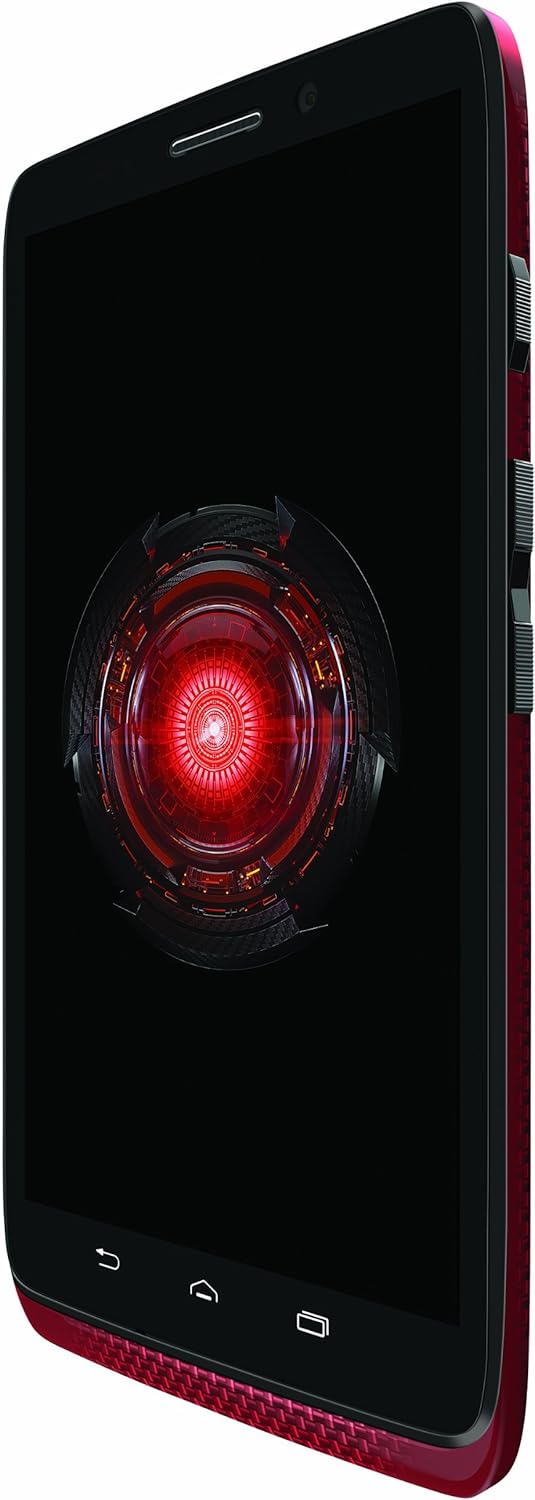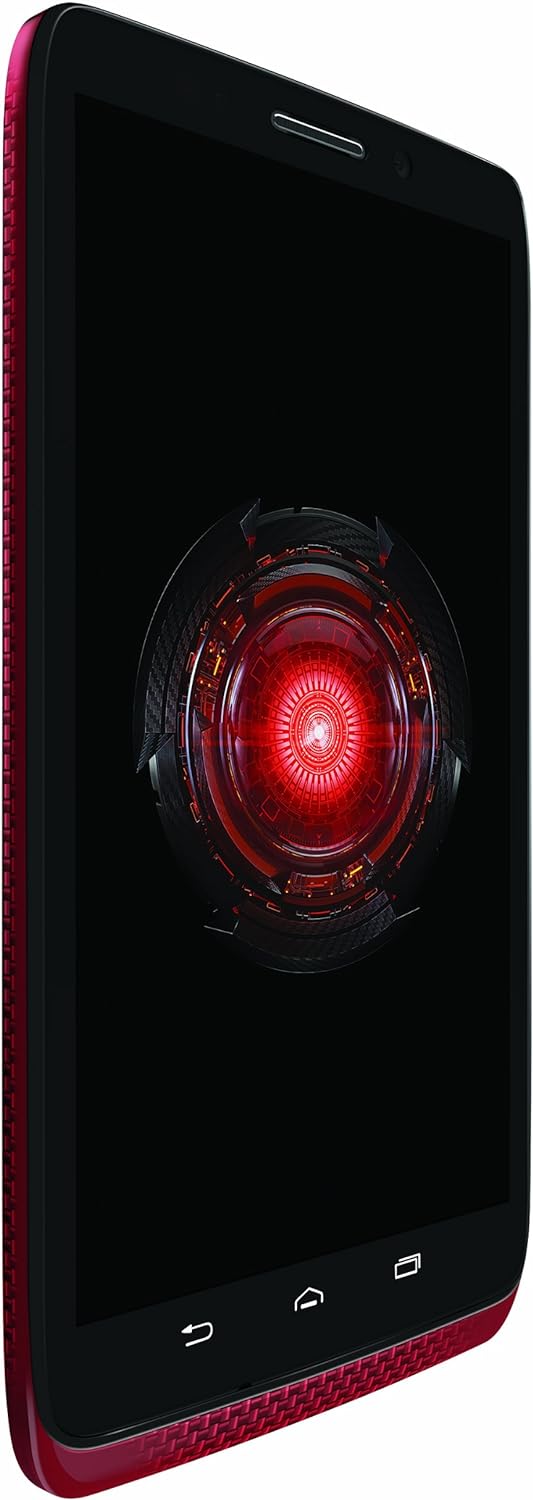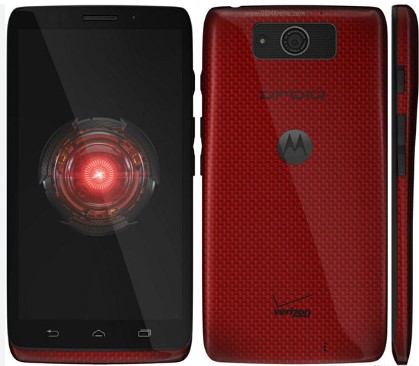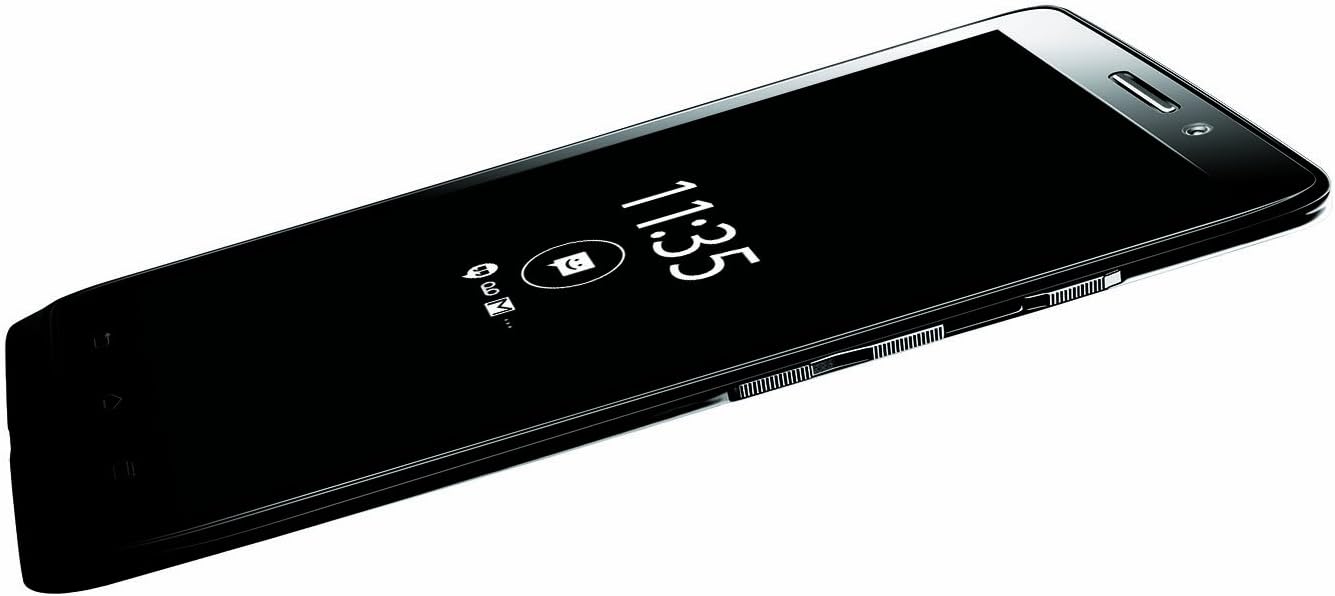The original Motorola DROID was the first device to, so to speak, work successfully on the Android platform. So we can say that the Motorola DROID is a phone that has started a revolution of epic proportions. As time went on, this original line of devices, promoted and used by the American giant Verizon, slowly gave way to the Galaxy series of smartphones coming from Samsung. However, these days Motorola is one step away from the official presentation of new members of this family: DROID Ultra, DROID MAXX and DROID mini.
Motorola and Verizon have decided to rekindle the fame of the old ace by introducing as many as three new phones.

DROID MAXX
The DROID MAXX is the new flagship model. This is a phone for people who do not want to agree to any compromises. This phone has top performance and a long-lasting battery, which is no wonder if we keep in mind that Motorola preferred high-capacity batteries even before the winter by Google. This MAXX is thinner than the previous model, because it has a seductive waist of only 8.5 mm. Its 3,500 mAh battery is enough for relaxed use of the phone for two days! At the same time, Motorola has set aside the option for wireless charging.

As for the interior, it has 2GB of RAM and 32GB of “ordinary” memory, while the entire device is powered by a dual-core processor with 1.7 GHz.

The DROID MAXX may not have the best design on the market, but its body, which looks like it was cast in one piece, is still worthy of a phone of this rank. Its weight of 167 grams is not so small, but for this massive device with a 5-inch screen, it may be the only possible one.

The screen is in HD and with its 720 × 1280 pixels it is not the best on the market, but it is certainly great and it will be hard to find any serious objections. In terms of multimedia equipment, MAXX has two cameras (2MP front and 10MP rear with LED Flash Clear Pixel technology).

Motorola DROID Maxx: In-Depth Analysis of Pros and Cons
Released in 2013, the Motorola DROID Maxx aimed to provide users with an extended battery life and a range of features for its time. Here’s an in-depth look at its strengths and weaknesses:
Pros:
1. Battery Life:
- 3500mAh Battery: The standout feature of the DROID Maxx is its large 3500mAh battery, providing extended battery life, making it suitable for users with high usage demands.
- Power-Saving Features: Motorola implemented power-saving features, optimizing battery life further, and making the device last through a full day or more.
2. Build Quality:
- Kevlar Back: Similar to other devices in the DROID series, the DROID Maxx features a Kevlar back, providing durability and a unique design.
- Solid Construction: The device has a sturdy build, contributing to a durable and reliable feel.
3. Display:
- 5.0-inch AMOLED Display: The device boasts a 5.0-inch AMOLED display, offering vibrant colors and deep blacks.
- 720 x 1280 Resolution: While not the highest resolution, the 720p display provides a satisfactory visual experience.
4. Performance:
- Motorola X8 Mobile Computing System: The DROID Maxx is powered by the Motorola X8 Mobile Computing System, featuring a dual-core CPU, quad-core GPU, and dedicated contextual computing cores.
- Efficient Operation: The combination of hardware components ensures smooth and efficient performance for everyday tasks.
5. Connectivity:
- 4G LTE Support: The inclusion of 4G LTE support enables fast data speeds, contributing to improved internet connectivity.
- NFC and Bluetooth: NFC capabilities and Bluetooth support offer convenient wireless connectivity options.
6. Camera Capabilities:
- 10MP Rear Camera: The 10-megapixel rear camera captures decent photos for its time, and it features clear pixel technology for enhanced image quality.
- Quick Capture Feature: The Quick Capture feature allows users to launch the camera quickly with a simple wrist twist gesture.
7. Touchless Controls:
- Voice Commands: Similar to other Motorola devices, the DROID Maxx includes touchless controls, allowing users to interact with the device using voice commands, providing a hands-free experience.
8. Moto Display Feature:
- Active Display: The Moto Display feature provides at-a-glance notifications on the lock screen, enabling users to check messages without unlocking the device.
9. Software Experience:
- Near-Stock Android: The device runs on a near-stock version of Android, offering a clean and straightforward user interface.
- Timely Updates: Being a Motorola device, it received relatively timely Android updates during its supported lifecycle.
10. Storage Options:
- Ample Storage: The DROID Maxx comes with ample internal storage options, allowing users to store apps, media, and files.
Cons:
1. Display Resolution:
- 720p Resolution: While the AMOLED display is vibrant, the 720p resolution may be considered lower compared to more recent devices, impacting pixel density.
2. Limited Camera Features:
- Basic Camera Software: The camera software may lack some advanced features and modes seen in newer smartphones, limiting photography enthusiasts.
3. Non-Removable Battery:
- Fixed Battery: The large 3500mAh battery is not user-replaceable, which might be a drawback for users who prefer devices with removable batteries.
4. Outdated Operating System:
- Android 4.2.2 Jelly Bean: The DROID Maxx shipped with Android 4.2.2 Jelly Bean, and while it received updates during its lifespan, it may not support the latest Android versions.
5. Limited RAM:
- 2GB RAM: While 2GB of RAM was sufficient during its release, newer applications and software updates may push the limits of its memory capacity.
6. No Expandable Storage:
- Lack of MicroSD Slot: The absence of a microSD card slot limits expandable storage options, and users are reliant on the built-in storage.
7. Design Preferences:
- Subjective Design: While the Kevlar back adds durability, the design might be subjective, and some users may prefer different materials or aesthetics.
8. No Fingerprint Sensor:
- Lack of Biometric Security: The device does not feature a fingerprint sensor or any advanced biometric security options.
9. Obsolete Hardware:
- Outdated Processor: The Motorola X8 Mobile Computing System, while efficient in its time, is outdated compared to modern processors.
10. Limited Customization:
- Non-Removable Back: The Kevlar back, while durable, means users cannot change the back cover for customization or personalization.
In summary, the Motorola DROID Maxx, with its emphasis on battery life and durability, caters to users with specific needs. While it may lack some modern features, its extended battery capacity and Motorola’s software optimizations make it a viable option for those seeking a reliable device with a focus on longevity.
DROID Ultra

For those who do not want to give up high performance, but not the slim body that MAXX has, DROID Ultra could be the right solution. This phone, when it appears on the market, will try to be the thinnest, with a waist of only 7.18 mm, which is certainly an ambitious plan. The DROID Ultra should have an identical processor as the MAX, but also cameras and a diagonal and screen resolution. Still, it will be slightly lighter than the massive MAXX and will have a smaller battery, with a capacity of 2,130mAh.

Motorola DROID Ultra: In-Depth Analysis of Pros and Cons
The Motorola DROID Ultra, released in 2013, was part of the DROID series and aimed to provide a balance of performance and features for users. While it may not be the latest device, here’s a comprehensive look at its strengths and weaknesses:

Pros:
1. Design and Build Quality:
- Kevlar Back: The device features a Kevlar back, providing durability and a unique textured finish.
- Slim and Lightweight: With a slim profile, it is lightweight and easy to handle, making it convenient for daily use.
2. Display:
- 5.0-inch AMOLED Display: The DROID Ultra boasts a vibrant 5.0-inch AMOLED display, offering rich colors and deep blacks.
- 720 x 1280 Resolution: The HD resolution contributes to a sharp and clear viewing experience.
3. Performance:
- Motorola X8 Mobile Computing System: The device is powered by the Motorola X8 Mobile Computing System, including a dual-core CPU, quad-core GPU, and dedicated natural language and contextual computing cores.
- Smooth Operation: The combination of hardware components ensures smooth overall performance and responsiveness.
4. Battery Life:
- 2130mAh Battery: The device is equipped with a 2130mAh battery, providing sufficient power for a full day of moderate usage.
- Power-Saving Features: Motorola’s optimization features contribute to efficient power management.
5. Connectivity:
- 4G LTE Support: The inclusion of 4G LTE support enables fast data speeds and improved connectivity.
- NFC and Bluetooth: NFC capabilities and Bluetooth support offer convenient wireless connectivity options.
6. Camera Capabilities:
- 10MP Rear Camera: The 10-megapixel rear camera captures decent photos with Motorola’s clear pixel technology.
- Quick Capture Feature: The Quick Capture feature allows users to launch the camera with a quick wrist twist gesture.
7. Touchless Controls:
- Voice Commands: Motorola’s touchless controls enable users to interact with the device using voice commands, adding a hands-free element to the user experience.
8. Moto Display Feature:
- Active Display: The Moto Display feature provides at-a-glance notifications on the lock screen, allowing users to check messages and updates without unlocking the device.
9. Software Experience:
- Near-Stock Android: The device runs a near-stock version of Android, offering a clean and user-friendly interface.
- Timely Updates: Being a Motorola device, it received relatively timely Android updates during its supported lifecycle.
10. Storage Options:
- Ample Storage: The device comes with options for ample internal storage, allowing users to store apps, media, and files.

Cons:
1. Display Resolution:
- 720p Resolution: While the display is vibrant, the 720p resolution may be considered lower compared to contemporary devices, impacting pixel density.
2. Limited Camera Features:
- Limited Camera Software: The camera software may lack some advanced features and modes seen in newer smartphones, limiting photography enthusiasts.
3. Non-Removable Battery:
- Fixed Battery: The 2130mAh battery is not user-replaceable, which might be a drawback for users who prefer devices with removable batteries.
4. Outdated Operating System:
- Android 4.2.2 Jelly Bean: The device shipped with Android 4.2.2 Jelly Bean, and while it received updates during its lifespan, it may not support the latest Android versions.
5. Limited RAM:
- 2GB RAM: While 2GB of RAM was sufficient during its release, newer applications and software updates may push the limits of its memory capacity.
6. No Expandable Storage:
- Lack of MicroSD Slot: The absence of a microSD card slot limits the expandable storage options, and users are reliant on the built-in storage.
7. Design Preferences:
- Subjective Design: While the Kevlar back adds durability, the design might be subjective, and some users may prefer different materials or aesthetics.
8. No Fingerprint Sensor:
- Lack of Biometric Security: The device does not feature a fingerprint sensor or any advanced biometric security options.
9. Limited Customization:
- Non-Removable Back: The Kevlar back, while durable, means users cannot change the back cover for customization or personalization.
10. Obsolete Hardware:
- Outdated Processor: The Motorola X8 Mobile Computing System, while efficient in its time, is outdated compared to modern processors.
In summary, the Motorola DROID Ultra
, despite its age, offers a combination of durability, performance, and essential features. However, its limitations, such as the outdated operating system and non-removable battery, should be considered by users seeking a device with more contemporary specifications and features.
DROID Mini

The DROID Mini for Motorola could be the same as the One Mini for HTC. This compact Android phone should have the power of an Ultra model, but in a smaller “package” with a 4.3-inch screen, but also with the same resolution of 720 × 1280 pixels.
All three models will have Touchless Control, ie the option of contactless control, but also an interesting option called Active Display, which will illuminate only certain parts of the screen, if necessary, to see some important data, such as the clock or missed calls. This option will definitely work on AMOLED screens in MAXX and Ultra models, while on the Mini’s LCD screen it could be a bit less successful.
Motorola DROID Mini: In-Depth Analysis of Pros and Cons
Released in 2013, the Motorola DROID Mini aimed to offer a compact form factor without compromising too much on features. Let’s delve into the device’s strengths and weaknesses:
Pros:
1. Compact Size:
- 4.3-inch Display: The DROID Mini is designed for users who prefer smaller devices, featuring a 4.3-inch display that allows for easy one-handed use.
2. Build Quality:
- Kevlar Back: Similar to other devices in the DROID series, the DROID Mini features a Kevlar back, providing durability and a unique design.
- Solid Construction: The device has a sturdy build, contributing to a durable and reliable feel.
3. Display Quality:
- 720p Resolution: Despite its compact size, the device boasts a 720p resolution, offering satisfactory display quality with decent pixel density.
4. Performance:
- Motorola X8 Mobile Computing System: The DROID Mini is powered by the Motorola X8 Mobile Computing System, featuring a dual-core CPU, quad-core GPU, and dedicated contextual computing cores.
- Efficient Operation: The combination of hardware components ensures smooth and efficient performance for everyday tasks.
5. Connectivity:
- 4G LTE Support: The inclusion of 4G LTE support enables fast data speeds, contributing to improved internet connectivity.
- NFC and Bluetooth: NFC capabilities and Bluetooth support offer convenient wireless connectivity options.
6. Camera Capabilities:
- 10MP Rear Camera: The 10-megapixel rear camera captures decent photos for its time, and it features clear pixel technology for enhanced image quality.
- Quick Capture Feature: The Quick Capture feature allows users to launch the camera quickly with a simple wrist twist gesture.
7. Touchless Controls:
- Voice Commands: Similar to other Motorola devices, the DROID Mini includes touchless controls, allowing users to interact with the device using voice commands, providing a hands-free experience.
8. Moto Display Feature:
- Active Display: The Moto Display feature provides at-a-glance notifications on the lock screen, enabling users to check messages without unlocking the device.
9. Software Experience:
- Near-Stock Android: The device runs on a near-stock version of Android, offering a clean and straightforward user interface.
- Timely Updates: Being a Motorola device, it received relatively timely Android updates during its supported lifecycle.
10. Storage Options:
- Ample Storage: The DROID Mini comes with ample internal storage options, allowing users to store apps, media, and files.
Cons:
1. Compact Size Limitations:
- Small Display: While some users appreciate the compact size, others may find the 4.3-inch display restrictive, especially for multimedia consumption.
2. Display Quality:
- Lower Pixel Density: The 720p resolution, while suitable for the size, results in a lower pixel density compared to larger devices, affecting the clarity of text and images.
3. Non-Removable Battery:
- Fixed Battery: The non-removable battery might be a drawback for users who prefer devices with user-replaceable batteries for extended use.
4. Outdated Operating System:
- Android 4.2.2 Jelly Bean: The DROID Mini shipped with Android 4.2.2 Jelly Bean, and while it received updates during its lifespan, it may not support the latest Android versions.
5. Limited RAM:
- 2GB RAM: While 2GB of RAM was sufficient during its release, newer applications and software updates may push the limits of its memory capacity.
6. No Expandable Storage:
- Lack of MicroSD Slot: The absence of a microSD card slot limits expandable storage options, and users are reliant on the built-in storage.
7. Design Preferences:
- Subjective Design: While the Kevlar back adds durability, the design might be subjective, and some users may prefer different materials or aesthetics.
8. No Fingerprint Sensor:
- Lack of Biometric Security: The device does not feature a fingerprint sensor or any advanced biometric security options.
9. Obsolete Hardware:
- Outdated Processor: The Motorola X8 Mobile Computing System, while efficient in its time, is outdated compared to modern processors.
10. Limited Customization:
- Non-Removable Back: The Kevlar back, while durable, means users cannot change the back cover for customization or personalization.
In summary, the Motorola DROID Mini catered to a niche market seeking a compact device without compromising too much on essential features. While it offered a unique size and build, certain limitations, such as the non-removable battery and compact display, need to be considered based on individual preferences and usage patterns.

